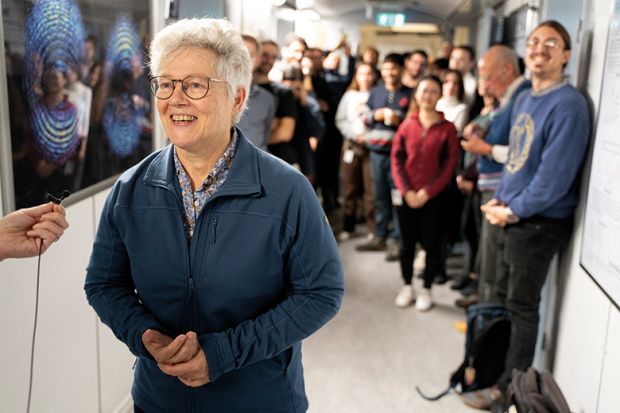The story of how Anne L’Huillier learned mid-lecture that she had received a Nobel prize but returned to finish her presentation – without divulging her win to students – has entered scientific folklore.
It’s a neat tale – of a scientist unmoved by triumph or disaster, of an educator utterly committed to their students’ learning regardless of their own personal glory – but the story that spilled out on social media last year is not entirely accurate, said Professor L’Huillier, who is only the fifth woman to take the Nobel Prize in Physics.
“I was alone when I picked up the phone and was asked to keep it a secret for an hour or so,” the French physicist told Times Higher Education. “The academy asked me to stay on the line, but I had 100 students waiting for me in the lecture, so I had to go back,” said Professor L’Huillier, speaking at the annual Lindau Nobel Laureate Meeting, held in southern Germany earlier this month.
Although she remained focused on her talk, Professor L’Huillier said her students at Lund University in Sweden, where she has worked since 1994, began to suspect that something big was going down, she continued. “I think students guessed what had happened – I wasn’t very comfortable to keep going with the lecture. But it was nice eventually,” said Professor L’Huillier, who relented and ended her talk a few minutes early so she could officially accept science’s top honour.
“It was a nice moment with students around, and I think they liked being part of my Nobel prize,” she reflected.
To have a Nobel laureate teaching minutes before gaining their award is unusual, but the fact that Professor L’Huillier was anywhere near a lectern is arguably more notable because elite researchers are usually happy to ditch undergraduate teaching early in their careers if possible.
Professor L’Huillier’s career, in this respect, is arguably back to front – she started teaching only a decade or so into her university career. Having taken a PhD in experimental physics at Pierre and Marie Curie University, the Paris-born scientist held research posts at the University of Gothenburg and the University of Southern California before accepting a permanent position at the Saclay Nuclear Research Centre, known as CEA Saclay.
“I didn’t do any teaching because I was at a research institution, and I was happy there,” Professor L’Huillier said.
However, her move to Sweden in 1994, the same year she married fellow physicist Claes-Göran Wahlström, meant that she was required to start teaching. “It was difficult to come into a different system and teach – particularly as I had to give my lessons in Swedish. That certainly helped me improve my Swedish,” she reflected. “However, I discovered teaching [at Lund], and that’s been very important to me.”
Some scholars argue that teaching helps their research, among them Nobel laureates such as Rainer Weiss, who sought different answers to gravitational wave theory from the ones he was asked to teach in class. But not Professor L’Huillier, who was honoured for her research on ultrafast laser science – which, thanks to “attosecond” pulses, may allow scientists to peer inside neutrons or observe ultrafast changes as chemical bonds break down.
“Teaching is not so useful for my research. I continue because I love teaching – it provides a nice balance with my research work,” she said.
With a few different choices, that might have been her métier, continued Professor L’Huillier. “I studied maths for a long time and wanted to be a teacher in maths,” she reflected.
But her fascination with applying knowledge to problems – inspired by watching, at the age of 11, Neil Armstrong walk on the moon – eventually pulled her towards a research career. “I didn’t want to become an astronaut – I was just amazed by the science and technology it took to do this,” she said.
“And then I was inspired by the French scientist Serge Haroche [the 2012 physics Nobel winner] as he did theory and experiments, so my motivation was also to do both.”
As one of only three women alive to hold a Nobel Prize in Physics, Professor L’Huillier frequently gets questions about how more women might be supported to reach the top of a field still dominated by men.
Asked if institutions need to provide more generous support for female scientists – such as the six-month career break she took after the birth of her two sons – she seemed almost shocked by the question. “Parental leave is shared by men and women in Sweden,” she said of the 480 days of leave currently granted to couples, adding that the matter of leave will be “very individual and depends on the family”.
Balancing teaching, research and family commitments has been “tough” throughout her career, admitted Professor L’Huillier.
But the impact of great educators on her own life means that she is still committed to staying in the classroom, “although not every day”. “I was inspired by my physics teacher in France – maybe my Nobel shows the impact that teaching in universities can have.”
POSTSCRIPT:
Print headline: The Nobelist who remains a class act
Register to continue
Why register?
- Registration is free and only takes a moment
- Once registered, you can read 3 articles a month
- Sign up for our newsletter
Subscribe
Or subscribe for unlimited access to:
- Unlimited access to news, views, insights & reviews
- Digital editions
- Digital access to THE’s university and college rankings analysis
Already registered or a current subscriber?








